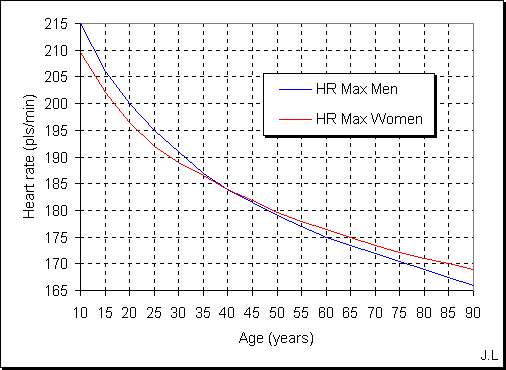It's the number of contractions of the heart (pulsations) per minute.
This parameter is the most used as the most easily measurable.
Frequency increases almost linearly with the effort but only for low to moderate efforts (see: effort zones).

Cardiovascular system
The cardiovascular system is responsible for the distribution of the biochemical elements required by the different metabolisms.
It consists of a double pump (the heart) and two types of pipes (arteries and veins) to transport blood.
The heart is a striated muscle that contracts (systole) and relaxes (diastole) to circulate the blood with O2 (left side) and CO2 (right side).
The arteries carry blood from the heart to the organs while the veins return blood from organs to the heart. Unlike veins, arteries have an elasticity and contractile power which play an important role for blood flow control.
The capillaries provide continuity between the arteries and veins, they form a dense network to irrigate the tissues.
Mechanical circulatory
Many parameters are involved in the functioning of the cardiovascular system, the most importants are the followings:
|
• Heart rate FC It's the number of contractions of the heart (pulsations) per minute. This parameter is the most used as the most easily measurable. Frequency increases almost linearly with the effort but only for low to moderate efforts (see: effort zones). |

|
|
• Systolic ejection volume VES It's the volume of blood ejected into the arteries with each contraction of the heart. It depends heavily on the time of contraction which means it decreases with high heart rates. It doesn't move linearly as function of effort. |

|
|
• Cardiac flow DC It's the product of the two previous parameters: DC = VES . FC This parameter is important because most directly associated to the produced power in an aerobic effort. The flow can vary from 5 litres/min at rest to over 20 litres/min in an intense effort or more than 30 litres/min for an endurance sportsman. |

|
Improvement
The training stages, specially the intensive and continuous efforts on long periods (endurance sports), improve the cardiovascular functioning. In maintaining continuously a high heart rate, training creates an hypertrophy of the heart which increases the systolic ejection volume and therefore improves the cardiac flow.
The most visible sign of this improvement is the lowering of the relax rate (40 to 50 pls/min instead of 60 to 70).
| Men (20 years - 70 kg) | ||||
| Type | Level | FC (pls/min) |
VES (ml/pls) |
DC (l/min) |
| Non-trained | Minimum | 72 | 70 | 5 |
| Maximum | 200 | 110 | 22 | |
| Trained | Minimum | 50 | 100 | 5 |
| Maximum | 190 | 180 | 34 | |
| Women (20 years - 50 kg) | ||||
| Type | Level | FC (pls/min) |
VES (ml/pls) |
DC (l/min) |
| Non-trained | Minimum | 75 | 60 | 4.5 |
| Maximum | 198 | 90 | 18 | |
| Trained | Minimum | 55 | 80 | 4.5 |
| Maximum | 192 | 125 | 24 | |
Relative importance
The cardiovascular system is the intermediary link of a chain including the respiratory system and the muscular structure. The role of this chain is to ensure the capture, the transport and the utilization of oxygen.
As in all chains, the weakest link limits the entirety. It is therefore necessary to develop each element based on the goal.
For example, a 10000 m runner who runs a 2000 m race, has a heart which beats far below the maximal rate. On this distance, the heart is too powerful relatively to the legs. In this case, the legs have not enough "fast" fibers and too much "slow" fibers.
At the opposite, a 2000 m runner who runs a 10000 m race, has a heart which beats near the maximal rate. On this distance, the heart is not enough powerful relatively to the legs. In this case, the legs have not enough "slow" fibers and too much "fast" fibers.
Attention !
The heart rate is not exactly representative of the effort because it's only one parameter of one link of the chain.
Others important parameters of this link (red corpuscles concentration, systolic ejection volume, vasodilatation, etc.) influence the rate and are able to fluctuate with time.
Maximum heart rate evolution as a function of age

N.B. These curves come from a statistical analysis about 2000 persons but a high level sportsman can be under or over depending on his cardiac morphology.
The often used formula "220 - age" is a rough linear approximation which has no sense over 35 years.